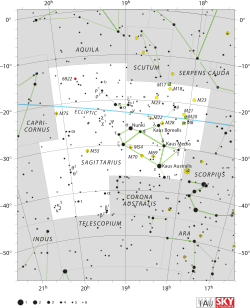Upsilon Sagittarii

Location of υ Sagittarii (circled) |
| Observation data Epoch J2000.0 Equinox J2000.0 | |
|---|---|
| Constellation | Sagittarius |
| Right ascension | 19h 21m 43.6s |
| Declination | −15° 57' 18" |
| Apparent magnitude (V) | +4.52 |
| Absolute magnitude (V) | −4.03 |
| Distance | 1672 ± 618 ly (513 ± 189 pc) |
| Spectral type | A5I + M5Ia[1] |
| Other designations | |
Upsilon Sagittarii (Upsilon Sgr, υ Sagittarii, υ Sgr) is a spectroscopic binary star system in the constellation Sagittarius. Upsilon Sagittarii is the prototypical hydrogen-deficient binary (HdB), and one of only four such systems known. The unusual spectrum of hydrogen-deficient binaries has made stellar classification of Upsilon Sagittarii difficult.
The primary component, Upsilon Sagittarii A, is most probably an A type supergiant. The radius of the primary is estimated at 60 solar radii, and its mass is estimated to be 25[1] solar masses. A is classified as an irregular variable and experiences apparent magnitude fluctuations between +4.51 and +4.65 with a period of approximately 20 days. Its mean apparent magnitude is +4.52.
The companion, Upsilon Sagittarii B, is massive, but so dim at visible frequencies as to be undetectable by optical telescopes. It is probably an M type supergiant, estimated to have a mass of 19[1] solar masses.
The binary system has an orbital period of 137.939 days and is approximately 1672 light years from Earth. It is predicted that at least one component of Upsilon Sagittarii will end its life in a supernova.
Naming
In Chinese, 建 (Jiàn), meaning Establishment, refers to an asterism consisting of υ Sagittarii, ξ² Sagittarii, ο Sagittarii, π Sagittarii, 43 Sagittarii and ρ¹ Sagittarii . Consequently, υ Sagittarii itself is known as 建六 (Jiàn liù, English: the Sixth Star of Establishment.)[2]
References
- ↑ 1.0 1.1 1.2 Hohle, M. M.; Neuhäuser, R.; Schutz, B. F. (April 2010), "Masses and luminosities of O- and B-type stars and red supergiants", Astronomische Nachrichten 331 (4): 349, arXiv:1003.2335, Bibcode:2010AN....331..349H, doi:10.1002/asna.200911355
- ↑ (Chinese) AEEA (Activities of Exhibition and Education in Astronomy) 天文教育資訊網 2006 年 5 月 11 日
- Dudley, R. E., Jeffery, C. S., 1990. Mon. Not. R. astr. Soc. 247, 400
| ||||||||||||||||||||||||||